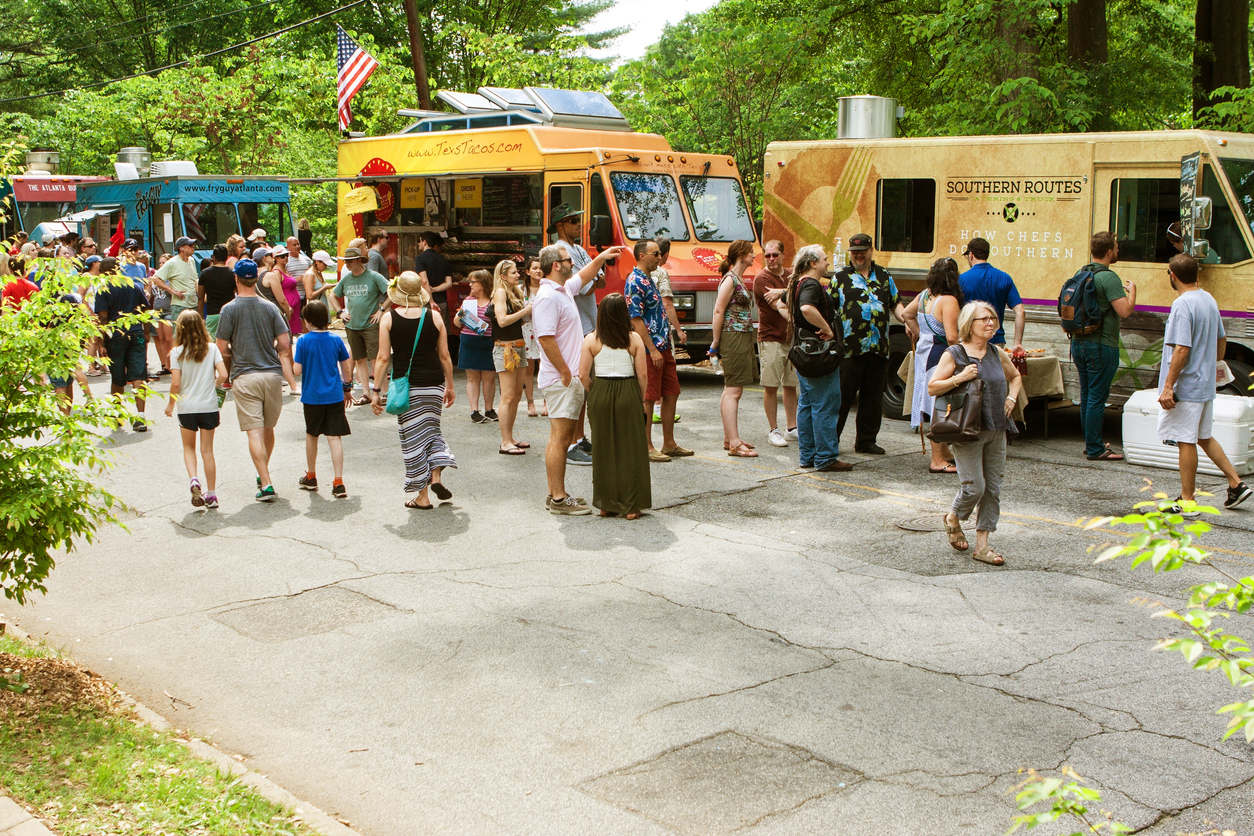
Starting a Mobile Food Truck Business in Texas – 2022

Starting a mobile food truck business is a lot of fun and, if you do it right, financially rewarding too. With the current increases in rent prices and more and more people enjoying “experimental” food spots, setting up a food truck may well be a worthwhile entrepreneurial pursuit in the present economic climate.
According to IBISWorld, an industry research firm, there were roughly 26,200 active food truck businesses in the US in 2021. Between 2016 and 2021, the number of food trucks rose by around 7.5% per year, four times faster than the fast-food industry as a whole. Predictions about the expansion of the American food truck industry until 2027 follow the same trend.
Many food truck owners are business owners who just want to do what they love – preparing delicious cuisine for hungry customers. However, as simple as this motivation is, translating a dream of cooking for the community into a real, physical mobile eatery is no easy feat.
To out-hustle the competition, the best food truck owners come up with menus that either boast innovative dishes or are filled with common favorites. One thing’s for sure – consistent, high-quality cuisine is always important. And this can mean working long hours, frequently late into the evening.
Prospective food trucks set the groundwork for success months before they serve their first meal, investing in hundreds of hours of behind-the-scenes effort to get a head start.
When it comes to setting up your own food truck business, there are several steps you should take to get things up and running. We recommend that you take your time and follow the steps below thoroughly.

1. Research the local food truck scene and laws
According to the Restaurant MBA, 60% of food truck enterprises fail within three years. The difference between a successful food truck and one that flops largely boils down to preparation. Accordingly, when starting up a food truck business, you must ensure that you are filling a gap in the market, meeting demand, and operating legally.
When conducting your preliminary research, consider the local food truck scene as well as any rules and regulations that may apply. This information will assist you in determining whether or not a food truck is a viable business venture for you. Speaking with other food truck entrepreneurs is also sure to provide you with much-needed industry knowledge.
2. Find a niche and plan your menu
If you’ve decided that starting a food truck is for you, then you can go ahead and start planning!
Finding your culinary specialization is the first step. Naturally, you’ll feel most at ease sticking to the cuisines and techniques you’re most familiar with. However, the true trick is to identify a niche within that comfort zone that no other local food truck appears to tackle. You want your mobile diner to stand out, perhaps with customers linking your eatery to a specific menu item over time.
Unlike traditional restaurants, food trucks cannot rely so heavily on an atmosphere or a feeling of place to attract customers. In other words, you can’t capitalize on the excitement of watching the “big game” like you can in a beer-soaked sports bar. This makes the quality and innovation of the food even more important.
Once you’ve decided on your niche, you can start preparing the menu. Designing a simple menu full of high-quality items can be an easy way to make sure all your dishes are available most of the time – using complex, hard-to-source ingredients isn’t necessarily a good idea when working in a mobile environment.
Basics such as sandwiches, burritos and burgers can, for instance, be paired with a variety of fillings to suit each individual’s taste. Desserts and snacks should follow the same principle. Come up with excellent concepts that you can improve over time as they gain traction.

3. Draw up a detailed business plan
It’s important to make detailed financial estimates for your first three years of operation. To do this, you should look at your projected set-up costs and ongoing expenses. Most, if not all, of the following topics should be considered in your business plan:
- Local food truck licensing requirements and fees
- Initial and continuous inspections by the local health authority, as well as standards for safe food service
- The operational type of your food truck (roving, residence-based, or something in between), as well as how much private catering you expect to undertake (if any)
- What kind of food truck you’ll require (a full-size truck or a small cart)
- Costs of your truck or cart, as well as any cooking equipment you plan to purchase
- If not simply in your mobile truck, where do you plan to make your meals? Consider the price of a cooking area, such as a commissary or charity commercial kitchen.
- Where you’ll park your truck at night
- Menu planning and ingredient expenses
- Parking, insurance, and business services are all ongoing overhead costs that should be included.
Download this business plan template, which includes a fully customizable financial model, and start your business plan.
4. Obtain funding for your food truck business
Completing your business plan will allow you to have a good estimate of your food truck costs and, in turn, your pre-revenue financing needs.
Though it’s possible that a bank or credit union may fund your entire startup phase based on your business plan, it’s more probable that you’ll need to juggle funding from numerous sources, especially if this is your first food business.
- Food truck grants – As food trucks are rather common business enterprises, one challenge that many food truck business owners encounter is sourcing funding. Luckily, many grants are available for small businesses such as food trucks.
- Food truck loans with security – A secured vehicle loan, similar to a car loan, is your best option for financing the purchase of either a new or reconditioned food truck. These loans have lower interest rates than unsecured loans, as they are secured by the truck’s worth. Interest rates for specialized commercial vehicles, such as food trucks, are likely to be higher than those for passenger automobiles. Speak to a business lending officer at a bank. And if all else fails, contact a food truck or trailer manufacturer.
- Unsecured digital loans or lines of credit – If a food truck or cart is the next step in the growth of your existing food business, look to digital lenders like OnDeck or Lending Club for funding. They can be quick to underwrite five- or six-figure loans for companies that have been in business for a long time (normally at least 12 months) and generate enough revenue (usually $100,000 or more per year). Food truck entrepreneurs can also turn to specialty lenders such as Food Truck Lender, which have more lenient requirements.
- Raising funds from friends and family members is a two-edged sword. On the one hand, it’s simpler to ask people you know and love to support your ambitions. However, you’ll need to have a plan in place to be able to repay their kindness.
- Crowdfunding – Unless you pledge to repay the money raised through crowdfunding, it’s not actually a loan. If you don’t qualify for a company loan or credit card, don’t want to use your personal money or equity, and don’t wish to approach your friends and family for help, this is probably your best option. Nevertheless, running a successful crowdfunding campaign is not easy. To persuade donors to donate, you’ll need to outline your business plan succinctly and provide a combination of branded merchandise, free food, and public recognition.
Update your business plan after you have a decent idea of how much money you’ll need and how much your business will cost in interest and fees each year.

5. Make your food truck known
Actively promoting your company will set you apart from your competitors. Proper marketing methods will ensure that you reach clients and potential buyers as soon as possible.
Here are some excellent food truck marketing strategies to consider:
- Social media promotion – The digital world is where the younger generations live and breathe, meaning you can use social media to reach a large segment of the population. To attract clients, it’s a good idea to develop an efficient Facebook company page or a Twitter profile, as well as hiring ‘digital nomads‘ to assist you with your marketing efforts.
- Review pages – Any business that wants to succeed should have a review page. Customers often read Google or Tripadvisor reviews before heading to a food establishment. Additionally, acquiring SEO services to appear at the top of search lists on the internet, as well as listing your business with Google or Yelp, can be extremely beneficial.
- Build your website – Having a professional-looking website can help you promote your business significantly. With your own website, any digital marketing approach will become more effective. You can use various search engines and social networking platforms to generate visitors to your website.
- Make contact with food bloggers – Getting in contact with food bloggers can be really useful. Food bloggers with a large enough following, especially in your area, can help you develop the buzz you need. Aside from bloggers, you may contact influencers who specialize in producing food-related podcasts and other kinds of content.
- Use the power of promotion – “Buy one get one free”, “Taco Tuesdays” or “Happy Hours” could help you drive your business. You may wish to use discount coupons and other promotional strategies to keep your customers interested.

6. Obtain the necessary permits and licenses
Food truck businesses are primarily regulated by the Department of State Health Services (DSHS) and the Texas Commission on Environmental Quality (TCEQ). However, it’s very important to contact local authorities before starting a food truck business, in order to find out local ordinances that apply to the food truck industry. Many cities, including Houston, Dallas, Austin, San Antonio, El Paso and Lubbock, have websites to help you comply with local requirements.
A complete list of compliance tools for food trucks in Texas can be obtained from the TCEQ’s website. (Note that these resources are not intended for single-service food concessions that only sell prepackaged food.)
What’s more, before a food truck can begin operations, entrepreneurs should consider incorporating the company. The following are some of the most common legal structures for this type of mobile business:
- Single-person businesses
- Partnerships
- Companies with Limited Liability (LLCs)
Following the incorporation of your food truck business, you should begin the process of making your food truck legal and compliant with state and federal standards.
First stop: the health department
Any food truck owner’s first stop should be at their local health department, where they will need to complete the following checklist:
- Obtain the necessary permits to operate a mobile food truck – a food management identification license, a food handler’s license, and a vending license are the first three licenses you’ll need.
- Following the acquisition of the aforementioned permits, you’ll require a list of items that you can make and sell from a mobile truck. This is also available through the health department.
Food truck business licenses
After dealing with the health department, you’ll need to go to the local business administration office and apply for an employer identification number. This number will need to be included on all of your business documents. This is critical, as failing to do so could result in significant fines that jeopardize your company’s success.
After receiving your business license and setting up your food truck, you’re expected to return to the health department to have your food truck inspected.

7. Find a location and a place to park
A food truck has the advantage of being able to move around according to where your customers are. While the likelihood of a standard brick-and-mortar restaurant failing remains high, the movable aspect of a food truck helps to improve your business’ chances of succeeding. You need to determine the best place to park that allows you to draw in a large number of customers. It’s also important to find out where you cannot park. Making a list of possible parking locations for your food truck will help things run more smoothly.
8. Truck or trailer insurance
Food truck insurance is substantially more expensive than passenger vehicle insurance. You’ll need to cover not only the vehicle but also the cooking and food storage equipment onboard, most likely with a commercial auto policy. Workers’ compensation insurance is also required if you have employees.
Running a food truck, like any small business, requires a significant amount of effort. Food truck owners who succeed work extremely hard, especially during the early stages when they lack brand recognition. Whether you’re launching your mobile diner in a huge city or a quieter rural location, following these steps will help you to set up a successful food truck and smash your business goals.
